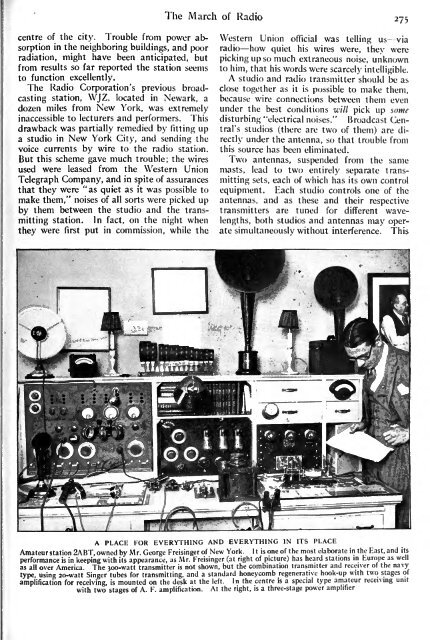Radio Broadcast - 1923, August - 86 Pages, 8.5 ... - VacuumTubeEra
Radio Broadcast - 1923, August - 86 Pages, 8.5 ... - VacuumTubeEra
Radio Broadcast - 1923, August - 86 Pages, 8.5 ... - VacuumTubeEra
- No tags were found...
You also want an ePaper? Increase the reach of your titles
YUMPU automatically turns print PDFs into web optimized ePapers that Google loves.
The March of <strong>Radio</strong> 275centre of the city. Trouble from power absorptionin the neighboring buildings, and poorradiation, might have been anticipated, butfrom results so far reported the station seemsto function excellently.The <strong>Radio</strong> Corporation's previous broadcastingstation, WJZ, located in Newark, adozen miles from New York, was extremelyinaccessible to lecturers and performers. Thisdrawback was partially remedied by fitting upa studio in New York City, and sending thevoice currents by wire to the radio station.But this scheme gave much trouble; the wiresused were leased from the Western UnionTelegraph Company, and in spite of assurancesthat they were "as quiet as it was possible tomake them," noises of all sorts were picked upby them between the studio and the transmittingstation. In fact, on the night whenthey were first put in commission, while theWestern Union official was telling us viaradio how quiet his wires were, they werepicking up so much extraneous noise, unknownto him, that his words were scarcely intelligible.A studio and radio transmitter should be asclose together as it is possible to make them,because wire connections between them evenunder the best conditions will pick up somedisturbing "electrical noises." <strong>Broadcast</strong> Central'sstudios (there are two of them) are directlyunder the antenna, so that trouble fromthis source has been eliminated.Two antennas, suspended from the samemasts, lead to two entirely separate transmittingsets, each of which has its own controlequipment. Each studio controls one of theantennas, and as these and their respectivetransmitters are tuned for different wavelengths,both studios and antennas may operatesimultaneously without interference. ThisA PLACE FOR EVERYTHING AND EVERYTHING IN ITS PLACEAmateur station 2ABT, owned by Mr. George Freisinger of New York. It is one of the most elaborate in the East, and itsperformance is in keeping with its appearance, as Mr. Freisinger (at right of picture) has heard stations in Europe as wellas all over America. The 3oo-watt transmitter is not shown, but the combination transmitter and receiver of the navytype, using 2O-watt Singer tubes for transmitting, and a standard honeycomb regenerative hook-up with two stages ofamplification for receiving, is mounted on the desk at the left. In the centre is a special type amateur receiving unitwith two stages of A. F. amplification. At the right, is a three-stage power amplifier
















